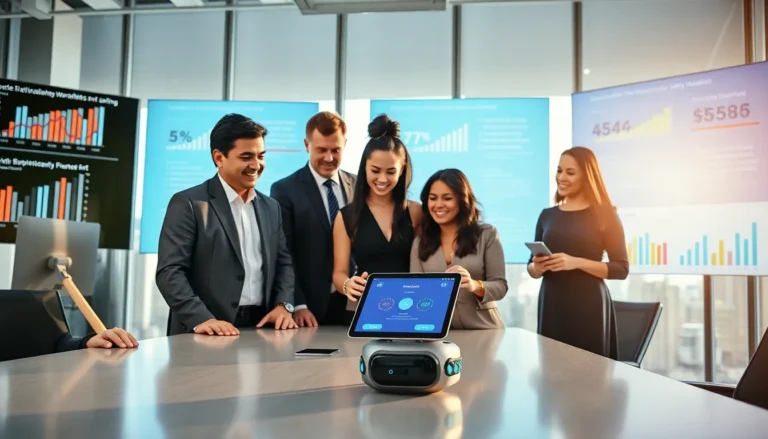Table of Contents
ToggleIn today’s tech-savvy world, the battle between tablets and laptops rages on like a sitcom rivalry. On one side, you’ve got the sleek and portable tablet, perfect for binge-watching shows or scrolling through social media while pretending to work. On the other, the trusty laptop stands tall, ready to tackle spreadsheets and essays with the ferocity of a caffeinated intern.
Choosing between these two gadgets can feel like deciding between pizza or tacos—both delicious but serving different cravings. Whether it’s the convenience of a tablet or the power of a laptop, understanding their strengths can save anyone from the tech equivalent of a bad haircut. Dive in to discover which device suits your lifestyle best and why one might just steal your heart (and your wallet).
Overview of Tablets vs Laptops
Tablets and laptops serve distinct purposes, catering to various user needs. Portability defines tablets. They weigh less and feature compact designs, making them ideal for on-the-go use. Entertainment, too, thrives on tablets, which excel at streaming videos, playing games, and browsing social media.
Laptops, on the other hand, provide power and versatility. They typically host more robust hardware, enabling complex tasks such as programming, graphic design, and video editing. Storage capacity often favors laptops, offering more space for software and files.
Operating systems differ significantly. Tablets commonly run on mobile systems, providing user-friendly interfaces, while laptops generally utilize full desktop operating systems. This difference impacts application usage; tablets optimize for touch-friendly apps, whereas laptops accommodate heavier software installations.
Battery life can vary. Tablets frequently boast longer battery life, lasting up to 10 hours, compared to laptops, which usually last around 5 to 8 hours depending on usage and model. Charging times also differ; tablets often charge faster due to their lower power requirements.
Cost is an important factor. Entry-level tablets can start as low as $200, while laptops typically require a higher investment, often beginning around $400. Pricing varies based on specifications and brands, influencing user decisions.
Consideration of intended use is crucial. For casual browsing and light applications, tablets may suffice. If heavy multitasking or intensive tasks are necessary, laptops likely prove more suitable. Understanding the specific needs helps users select the right device based on their lifestyle and preferences.
Key Differences Between Tablets and Laptops

Tablets and laptops cater to different needs and usage scenarios. Understanding their key differences helps viewers make an informed choice.
Performance
Performance varies significantly between tablets and laptops. Laptops typically feature stronger processors and more RAM, which enables handling complex applications like video editing and programming. Tablets, on the other hand, are designed for lighter tasks such as browsing or streaming, utilizing mobile processors for efficiency. Storage capacity also diverges, with laptops often accommodating larger hard drives or SSDs compared to tablets. While tablets excel in casual use, laptops emerge as the preferred choice for professional-grade performance.
Portability
Portability is a strong point for tablets. Weighing less than most laptops, tablets offer ease of transport, making them ideal for travel or quick errands. Many tablets boast sleek designs and smaller dimensions, allowing them to fit easily into bags. Laptops, while portable, generally weigh more and require larger cases. They may not be as convenient to carry around throughout the day. In scenarios where mobility matters most, tablets take the advantage.
User Experience
User experience differs between the two devices owing to their interfaces. Tablets often utilize touchscreens, providing intuitive navigation for users. Apps are easily accessible, and casual interaction feels seamless. Laptops, equipped with keyboards and trackpads, facilitate productivity for writing or programming tasks. The larger screens on laptops enhance engagement during extensive work or media consumption. Overall, the choice between touch-based interaction and traditional computing influences user preference.
Advantages of Tablets
Tablets offer several advantages that appeal to a wide range of users. Their lightweight design and sleek form make them easy to carry and use anywhere.
Touchscreen Interface
Touchscreen interfaces provide an intuitive and engaging user experience. Users often navigate apps, browse the web, and play games with simple taps and swipes. This hands-on approach fosters creativity and interaction, making it a popular choice for many. Accessibility is another benefit, as touchscreens cater to varied demographics, including children and older adults. Tablets typically incorporate features like stylus support, enhancing productivity for tasks like note-taking and sketching. Due to their versatile interface, tablets stand out as excellent tools for both leisure and professional activities.
Battery Life
Tablet devices frequently excel in battery life compared to laptops. Many tablets provide up to 14 hours of usage on a single charge, enabling users to stay unplugged throughout the day. Extended battery life supports activities like streaming, browsing, and gaming without interruption. Energy-efficient processors also contribute to longevity, ensuring that tablets remain functional during travel or long meetings. Users often appreciate the convenience of not searching for an outlet, particularly in busy environments. The combination of durability and energy savings positions tablets as compelling options for consumers prioritizing convenience.
Advantages of Laptops
Laptops offer several advantages that cater to various user needs.
Processing Power
Processing power stands out as a primary benefit of laptops. They typically feature more robust hardware, including faster processors and greater RAM, allowing them to handle demanding applications effectively. Graphics-intensive tasks such as video editing and gaming run smoothly on laptops. Various models come equipped with dedicated graphics cards, enhancing performance further for complex tasks. As a result, users completing intensive work projects find that laptops provide the performance necessary for productivity.
Software Compatibility
Software compatibility is another significant advantage of laptops. Most standard software applications run seamlessly on laptops, making them suitable for professionals across industries. This includes full versions of productivity tools like Microsoft Office and design programs such as Adobe Creative Suite. Many specialized software programs often lack tablet versions, limiting users’ options. With laptops, users maintain access to a vast array of applications, ensuring they can perform tasks needing specific software functionality without compromise.
Choosing between a tablet and a laptop comes down to individual needs and preferences. Tablets shine in portability and ease of use making them perfect for casual activities like streaming and browsing. Their lightweight design and long battery life cater to those constantly on the move.
On the other hand laptops provide the power and functionality required for more demanding tasks. For users who need robust performance for work or creative projects laptops are often the better choice.
Ultimately both devices offer unique advantages. Understanding these differences empowers users to select the device that best fits their lifestyle and requirements.




